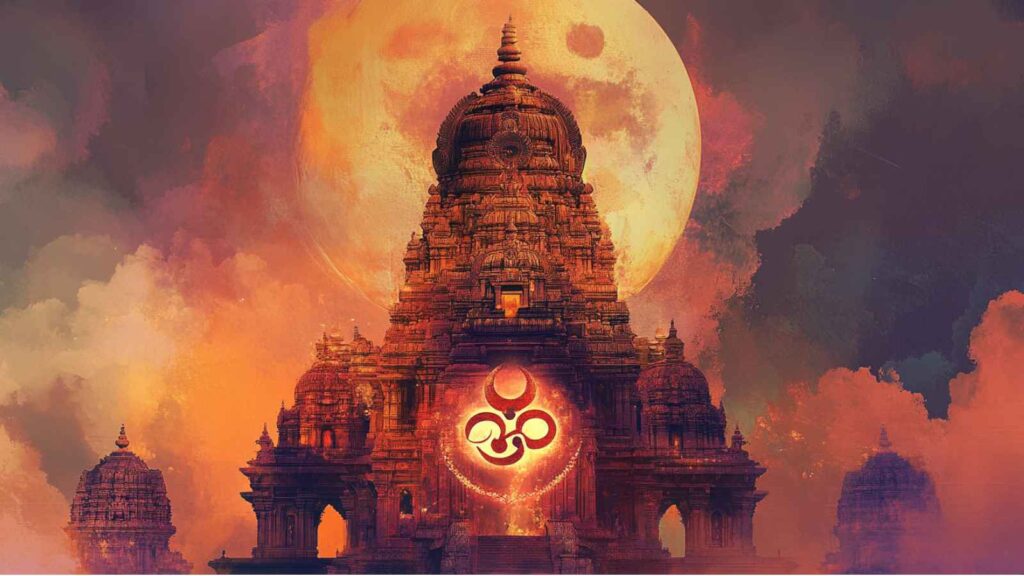Om (Aum): The Sacred Sound and Symbol of Hinduism
Om (Aum) is much more than a simple sound—it is the primordial vibration that encapsulates the essence of the entire universe. Regarded as the most sacred syllable in Hinduism, Om represents the trinity of existence: creation, preservation, and dissolution. It is both a sound and a symbol, an embodiment of ultimate reality that pervades all life and connects the individual self (Atman) with the universal consciousness (Brahman).
Read More About Hinduism Festivals
In this comprehensive exploration, we delve into the profound significance of Om as detailed in ancient scriptures, examine its philosophical and ritualistic guidance, and take you on a journey to visit iconic temples that celebrate this sacred sound. From the eternal verses of the Mandukya Upanishad to the hallowed corridors of temples such as the Omkareshwar Temple in Madhya Pradesh and Om Shanti Mandir in Pune, this article unveils the spiritual legacy of Om—a symbol that continues to inspire millions of seekers around the globe.
Foundational Scriptures: The Wisdom Behind Om

The power of Om is enshrined in some of Hinduism’s most revered texts, offering guidance on the nature of reality, consciousness, and the universe. These scriptures have inspired centuries of ritual practice, meditation, and philosophical inquiry.
The Mandukya Upanishad
The Mandukya Upanishad is entirely dedicated to the syllable Om. This ancient text explains that Om encompasses the totality of existence, symbolizing the past, present, and future. It describes the sound as having four aspects:
- A (or Adi): Represents the waking state and the manifest world.
- U (or Utpatti): Symbolizes the dream state and the subtle realm.
- M (or Mriya): Denotes deep sleep and the unmanifest state.
- The Fourth (Turiya): Transcends all states, representing pure consciousness and ultimate reality.
This Upanishad serves as a spiritual manual for understanding the nature of consciousness, emphasizing that meditating on Om can lead to self-realization and liberation (Moksha).
The Bhagavad Gita and Other Vedic Texts
In the Bhagavad Gita, Om is mentioned as a sacred incantation that can calm the mind and aid concentration during meditation. Vedic hymns also reference Om as the sound of creation, affirming its role in the cosmic order and its power to invoke divine energy. The recurring presence of Om in these texts underscores its function as a bridge between the human soul and the infinite.
Ritual Manuals and Astrological Texts
Ancient ritual texts such as the Agni Purana provide detailed guidance on how to incorporate Om into daily worship and ceremonial practices. These texts recommend chanting Om during meditation, prayer, and even before beginning any ritual activity, ensuring that every act is imbued with spiritual significance. Astrological texts, on the other hand, emphasize the importance of Om in harmonizing the energies of the cosmos, aligning personal endeavors with the rhythm of the universe.
Together, these scriptures establish Om as the eternal sound that vibrates through all creation, offering both a practical guide for spiritual practice and a profound philosophical framework for understanding existence.
Iconic Temples Celebrating Om (Aum)

Throughout India, the sacred sound of Om is celebrated not only in scriptural recitations but also through magnificent temples. These temples are architectural marvels that encapsulate centuries of devotion, art, and spirituality. Below, we explore two iconic temples that embody the essence of Om.
Temple 1: Omkareshwar Temple, Madhya Pradesh
Name & Exact Location
- Temple Name: Omkareshwar Temple
- Location: Omkareshwar, Khandwa District, Madhya Pradesh, India
Historical Background
Omkareshwar Temple is one of the 12 Jyotirlinga shrines dedicated to Lord Shiva, but its name itself—Omkareshwar—directly alludes to the sacred syllable Om. According to legend, the island of Mandhata in the Narmada River (known as Omkareshwar) is where Lord Shiva manifested as Omkareshwar, thus infusing the region with the powerful vibration of Om. Dating back to ancient times, the temple has been a focal point for pilgrims who believe that worshipping here not only honors Shiva but also the primal sound of the universe.
Historical records suggest that the temple has undergone several renovations over the centuries. It has been patronized by various dynasties, including the Paramaras and the Mughals, each contributing to its evolution as a symbol of spiritual resilience and cosmic energy.
Architectural Highlights
- Celestial Chariot of Om:
The temple’s layout is designed to evoke the cosmic form of Om. The sanctum sanctorum is richly adorned with carvings that depict the Om symbol in its various aspects, along with intricate sculptures of Shiva in meditation. - Intricate Stone Carvings:
The outer walls and pillars feature detailed carvings that narrate mythological episodes and celebrate the universal sound. These carvings blend geometric precision with artistic flourish, creating a visual representation of cosmic order. - Harmonious Integration with Nature:
Built on an island in the Narmada River, the temple’s design takes full advantage of its natural surroundings. The interplay of water, stone, and sky enhances the spiritual ambiance, symbolizing the fluidity and continuity of life. - Restoration and Preservation:
Recent conservation efforts have meticulously preserved the temple’s historical integrity while incorporating modern amenities for visitors, ensuring that the ancient aura of Om remains vibrant and accessible.
Visitor Experience
- Spiritual Awakening:
Pilgrims visiting Omkareshwar Temple often experience a profound sense of calm and rejuvenation. The rhythmic chanting of Om during early morning rituals, combined with the gentle flow of the Narmada, creates an immersive spiritual experience. - Cultural and Religious Festivals:
Major festivals such as Mahashivaratri and Omkareshwar Mahotsav draw thousands of devotees, who participate in elaborate processions, cultural programs, and night-long vigils, celebrating the divine sound of Om. - Guided Heritage Walks:
The temple complex offers guided tours that explain the historical and architectural significance of the site. Visitors gain insights into the ancient symbolism of Om, the temple’s evolution, and its role in the local cultural landscape. - Photography and Contemplation:
The unique architecture and scenic river backdrop make Omkareshwar Temple a favorite spot for photography enthusiasts. Many visitors also find quiet nooks within the temple complex ideal for meditation and reflection.
Temple 2: Om Shanti Mandir, Pune, Maharashtra
Name & Exact Location
- Temple Name: Om Shanti Mandir
- Location: Pimpri-Chinchwad, Pune, Maharashtra, India
Historical Background
Om Shanti Mandir, though relatively modern compared to ancient temples, has quickly become a beacon of peace and spiritual renewal in Pune. Founded in the late 20th century by a group of dedicated spiritual practitioners, the temple was established as a sanctuary where the profound energy of Om could be experienced in a tranquil setting. Its very name—Om Shanti (meaning “Om, Peace”)—captures the essence of its mission: to inspire inner peace and collective harmony.
Over the years, Om Shanti Mandir has grown into a vibrant community hub that hosts regular meditation sessions, yoga classes, and spiritual discourses. The temple’s contemporary design interweaves traditional symbolism with modern architectural principles, making it a unique representation of the evolving nature of Hindu worship.
Architectural Highlights
- Modern Interpretation of Ancient Symbols:
The temple’s architecture is a fusion of modern minimalism and traditional symbolism. The central dome is inscribed with the Om symbol in gold, serving as the focal point of the sanctuary. - Open and Airy Spaces:
Designed to facilitate meditation and communal gatherings, the temple features expansive halls and open courtyards. Large windows allow natural light to flood in, enhancing the serene ambiance. - Innovative Use of Materials:
Incorporating eco-friendly materials and contemporary design elements, Om Shanti Mandir reflects a commitment to sustainability while honoring ancient traditions. - Artistic Installations:
The temple houses several modern art installations that reinterpret traditional depictions of Om. These installations invite visitors to engage with the symbol on both a visual and emotional level, fostering a deeper connection with its universal message.
Visitor Experience
- Meditative Retreats:
Om Shanti Mandir offers a range of programs focused on meditation, mindfulness, and yoga. Visitors frequently remark on the temple’s calming atmosphere, which provides a welcome respite from the stress of modern urban life. - Workshops and Cultural Programs:
Regular workshops on spirituality, art, and holistic wellness are conducted at the temple, encouraging community participation and personal growth. - Community and Social Harmony:
The temple is a hub for social and cultural gatherings, where people from diverse backgrounds come together to celebrate peace and unity. This inclusive spirit enriches the visitor experience, making it both transformative and communal. - Interactive Tours and Exhibits:
For those interested in learning more about the significance of Om, interactive exhibits and guided tours are available. These educational experiences delve into the symbolism of Om, its historical evolution, and its relevance in contemporary spiritual practices.
The Sacred Symbol of Om: Philosophical and Ritual Significance
Om, often visualized as a beautiful and intricate symbol, is central to Hindu iconography and spiritual practice. It encapsulates the totality of existence and serves as a powerful tool for meditation, prayer, and inner transformation.
Om as a Microcosm of the Universe
The syllable Om is believed to represent the complete cycle of creation, preservation, and destruction. It is seen as the sound from which all existence emanates—a vibration that unifies the disparate elements of the cosmos. In this way, Om is not only a sacred symbol but also a profound philosophical concept that invites practitioners to contemplate the nature of reality itself.
Ritualistic Use of Om
- Chanting and Meditation:
Reciting Om is a common practice in meditation, where it is believed to help align the body and mind with the universal rhythm. Many devotees begin and end their daily rituals with the chanting of Om, creating a sacred space that nurtures inner peace. - Incorporation in Sacred Art:
The Om symbol is omnipresent in Hindu art and architecture, appearing on temple walls, in ritual objects, and even in the intricate designs of spiritual manuscripts. Its aesthetic appeal is matched by its deep spiritual significance.
Om in Modern Spirituality
In contemporary times, Om has transcended religious boundaries and is embraced worldwide as a symbol of peace, unity, and universal consciousness. Its universal appeal lies in its simplicity and the profound truth it represents: that all life is interconnected, vibrating at the same eternal frequency.

